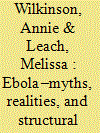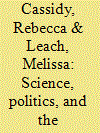|
|
|
Sort Order |
|
|
|
Items / Page
|
|
|
|
|
|
|
| Srl | Item |
| 1 |
ID:
137759


|
|
|
|
|
| Summary/Abstract |
TEN MONTHS AFTER THE FIRST INFECTION, Margaret Chan, Director-General of the World Health Organization, described the Ebola epidemic in West Africa as the ‘most severe acute public health emergency in modern times’. The disaster, she said, represents a ‘crisis for international peace and security’ and threatens the ‘very survival of societies and governments in already very poor countries’.1 As of October 2014, the disease had killed 4,951 and infected 13,567.2 It has crippled families, health systems, livelihoods, food supplies and economies in its wake. These numbers are likely to be vastly underestimated. How did it get to this? Why has this outbreak been so much larger than previous ones? The scale of the disaster has been attributed to the weak health systems of affected countries, their lack of resources, the mobility of communities and their inexperience in dealing with Ebola.3 This answer, however, is woefully de-contextualized and de-politicized. This briefing examines responses to the outbreak and offers a different set of explanations, rooted in the history of the region and the political economy of global health and development.
|
|
|
|
|
|
|
|
|
|
|
|
|
|
|
|
| 2 |
ID:
092984


|
|
|
|
|
| Publication |
2009.
|
| Summary/Abstract |
In early 2007 the President of a small African country announced his 'cure' for AIDS based on herbal, Islamic, and traditional medicine, resulting in the enrolment of several hundred people testing HIV-positive. This unleashed an ongoing yet remarkably silent controversy around AIDS treatment. The emergence of the presidential treatment can be understood in the political and scientific context of recent global AIDS funding and programming, and longstanding tensions between 'foreign' and local concerns with biomedicine and research. Framed in terms of appeals to tradition, ethnicity, religion, nation, and pan-Africanism, the President's programme appears diametrically opposed to mainstream scientific discourses. Yet in promoting and garnering support for his claims, this President has successfully co-opted and harnessed key elements of biomedical AIDS treatment discourse: in claims to identity as a doctor, and in deploying CD4 and viral load counts and personal testimonies as evidence of treatment efficacy. Uncertainty over how to interpret such evidence amongst vulnerable people living with HIV has encouraged many to volunteer. Such politics of science, along with the threatening political and security practices of this particular state, help explain why to date there has been so little overt criticism of the President's programme either within the country or internationally.
|
|
|
|
|
|
|
|
|
|
|
|
|
|
|
|
|
|
|
|
|